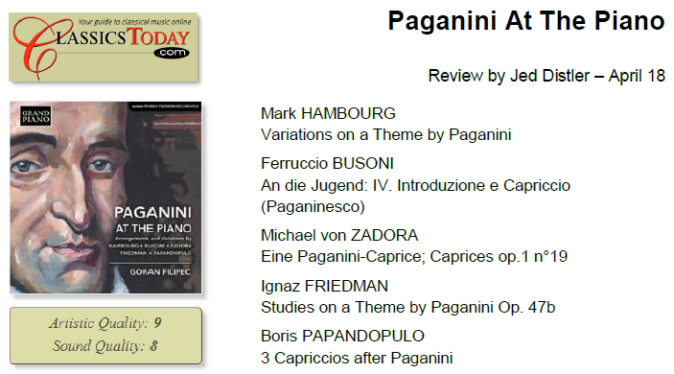Paganini’s solo violin Caprices Op. 1 have provided the basis for some of the piano repertoire’s iconic virtuoso vehicles, such as Brahms’ Op. 35 Variations and Rachmaninov’s Rhapsody, to name just two. For this release, however, pianist Goran Filipec uncovers some substantial lesser-known Paganini-inspired works.
Two large-scale variation sets based on the same 24th Caprice used by Brahms and Rachmaninov showcase composers who were primarily known as pianists, both prominent pupils of Theodor Leschetizky. The Russian-born Mark Hambourg eventually settled in England, where he amassed a popular following. Many of his old 78s are quite wild and technically all over the place: his Chopin Op. 42 Waltz, for example, is the pianistic parallel of an Ed Wood movie. By contrast, his Paganini Variations revel in thick, upholstered textures and a formidable though conservative harmonic rigor that might be described as the pianistic lovechild of Brahms and Anton Rubinstein. The work requires a pianist with the stamina of an ox and the ability to produce huge, unrelenting sonorities. Filipec not only takes Hambourg’s daunting demands in stride, but also makes the music’s monumental posturings seem more important than they are.
Ignaz Friedman’s Paganini Studies operate on a higher level of musical imagination and pianistic ingenuity, and Filipec clearly revels in the idiom, milking the slower variations for all they’re worth, albeit within the bounds of good taste. […].
Much as I admire Wolf Harden’s Naxos traversal of Busoni’s Introduzione e Capriccio for its poise and polish, Filipec’s more incisive, harder-hitting vantage point boasts the demonic edge. The Busoni pupil Michael von Zadora’s “Eine Paganini-Caprice”, based on the E-flat Caprice No. 19, smothers the original’s modest dimensions in heavy pianistic garb, but Filipec nevertheless makes the best case possible for this rare transcription. Boris Papandopulo’s three Capriccios fuse Lisztian sweep with spiky, Prokofiev-like dissonant jabs and steel-trap chords. The effects grow predictable as the music unfolds, yet these pieces fall gratefully and playfully under the fingers, at least under Filipec’s fingers. The detailed, close-up sonics grow slightly harsh and metallic in loud moments, but that hardly pulls focus from Filipec’s prodigious talent. Self-recommending to fanciers of Romantic piano rarities.

